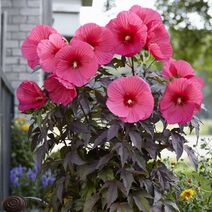Hibiscus moscheutos
| Hibiscus moscheutos | |
 | |
| Light: | |
| Moisture: | |
| Hardiness: | 5 |
| Soil pH: | 5.6-8.4 |
| Height: | 8' |
| Width: | 7' |
| Speed: | Moderate |
| Blooms: | Mid Summer-Early Fall |
| Native to: | |
| Nectary | |
| Edible Rating: | |
| Medicinal Rating: | |
| Tea: | Yes |
Hibiscus moscheutos (common names: swamp rose mallow, eastern rosemallow, and crimsoneyed rosemallow)
Propagation: Seed - sow early spring in a greenhouse. Germination is usually rapid. Prick out the seedlings when they are large enough to handle and plant them out into their permanent positions in early summer.
Some reports say that the seed can be sown in situ outside and that it gives a good rate of germination[1][2][3].
Cultivation: Prefers a well-drained humus rich fertile soil in a sheltered position in full sun[4]. Well-suited to a water-side planting[4].
One report says that the plants are hardy in zone 5 (tolerating winter temperatures down to about -25°c), this same report also says that the plant succeeds outdoors in Britain only in those areas where winter temperatures do not fall below about -5°c[4]. Another report says that it needs to be grown in a warm garden in the warmer areas of Britain[5]. Plants of the cultivar 'Southern Belle' have been seen growing outdoors at Kew Gardens, they are situated on a south-east facing wall of the Temperate House and have been there for at least 3 years as of 2000[K].
A very ornamental plant[6], there are many named varieties[4].
Range: Southern N. America - Massachusetts to Michigan, south to Alabama, Georgia and Florida,
Habitat: Saline marshes and the shores of lakes[7].
Edibility: Although there are no reports of edibility for this species, most of the plants in this family have edible leaves and flowers[K].
The flowers are about 15cm in diameter[5], though in some cultivars they are up to 25cm in diameter[7]. They have a mild flavour and somewhat mucilaginous texture with a slight bitterness in the aftertaste[K].
The leaves are rather bland and are also mucilaginous, but have a slight hairiness to them which detracts a little from the pleasure of eating them[K].
Medicinal: The leaves and roots abound in mucilage[8]. Like many other plants in this family, they are demulcent and emollient and are used in the treatment of dysentery, lung ailments and urinary ailments[8]. an infusion of the dried stalks has been used in the treatment of inflammation of the bladder[9].
Pollinators: Insects
Soil: Can grow in light, medium, and heavy soils.
Drainage: Prefers well drained soil.
Seed Ripens: Late Summer-Mid Fall
Flower Type: Hermaphrodite
Links
References
- ↑ Sheat, Wilfrid. Propagation of Trees, Shrubs and Conifers. St Martin, 1948.
- ↑ McMillan-Browse, Philip. Hardy Woody Plants from Seed. Grower Books, 1985.
- ↑ Dirr, Michael and Charles Heuser. The Reference Manual of Woody Plant Propagation. Athens Ga. Varsity Press, 1987.
- ↑ 4.0 4.1 4.2 4.3 Huxley, Anthony. The New Royal Horticultural Society Dictionary of Gardening. MacMillan Press, 1992.
- ↑ 5.0 5.1 Thomas, Graham. Perennial Garden Plants. J. M. Dent & Sons, 1990.
- ↑ Chittendon, Fred. RHS Dictionary of Plants. Oxford University Press, 1951.
- ↑ 7.0 7.1 Phillips, Roger and Martyn Rix. Conservatory and Indoor Plants Volumes 1 & 2. Pan Books, London, 1998.
- ↑ 8.0 8.1 Foster, Steven and Billy Tatum. Medicinal Plants of Eastern and Central North America. Houghton Mifflin, 1990.
- ↑ Moerman, Daniel. Native American Ethnobotany. Timber Press, 1998.